How Konev, Reuters and Rokossovsky tried to defeat Army Group Center

Photo https://pobedarf.ru
"Rzhev meat grinder"
During the offensive of the Red Army in the winter of 1941–1942, a ledge was formed in the western direction in the enemy’s defenses (up to 160 km in depth and up to 200 km wide at the base). The front line ran west of Bely, north and east of Rzhev, west of Yukhnov, east of Spas-Demensk. The German headquarters attached particular importance to holding the ledge, considering it as a springboard for a new offensive against Moscow. In the winter of 1942–1943 more than a third of the troops of the Army Group "Center" were concentrated here (9th Army, forces of the 3rd tank and 4th armies).
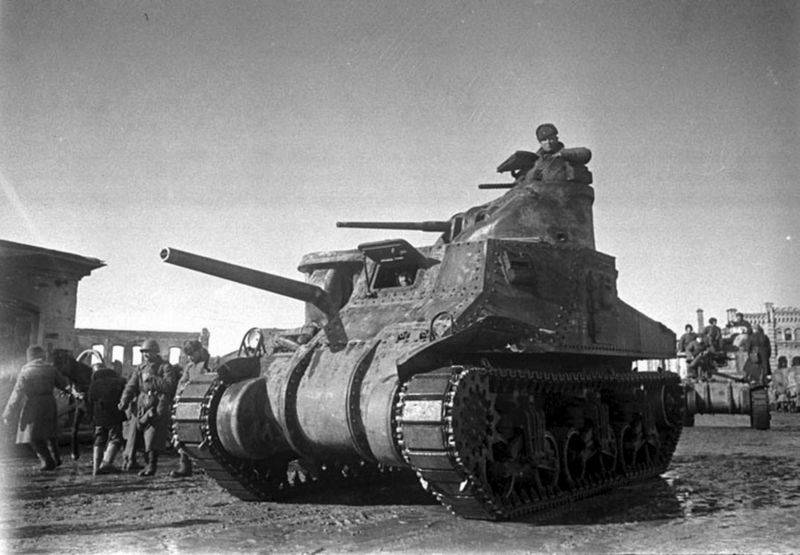
Soviet troops on American medium tanks M3 "General Lee" enter the liberated city of Vyazma
The Soviet Headquarters also attached great importance to this direction, trying to destroy the enemy bridgehead aimed at the capital. In winter - spring 1942, the troops of the Kalinin and North-Western fronts carried out the Rzhev-Vyazemsky operation. In July - October 1942, the Kalinin Front went on the offensive again - the Rzhev-Sychevskaya strategic offensive operation. In November - December 1942, the Soviet armies again tried to defeat the German 9th Army - the Second Rzhev-Sychevskaya strategic offensive operation (Operation Mars). The Red Army was unable to defeat the Wehrmacht in the Moscow direction during these long and bloody battles.
В history this battle was included as one of the longest and bloodiest, the "Rzhev meat grinder", in which, according to various estimates, from 1 to 2 million Soviet soldiers were lost killed and wounded. Only in March 1943, when the German 9th Army left the ledge, did the Soviet troops
pushed the front line away from Moscow by another 130–160 kilometers.
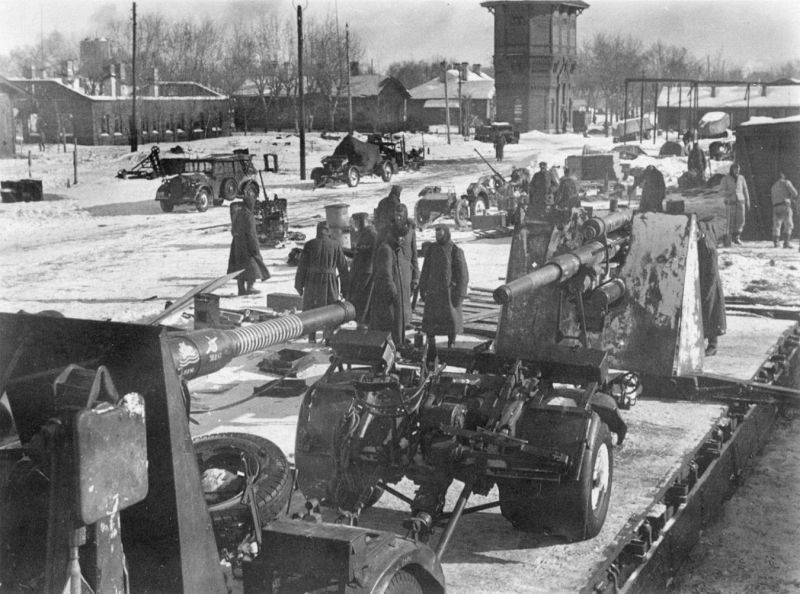
German 88 mm anti-aircraft guns (8,8 cm FlaK 36/37) on a railway platform in occupied Rzhev. Noteworthy is the number of white rings on the gun barrels - marks of damaged vehicles
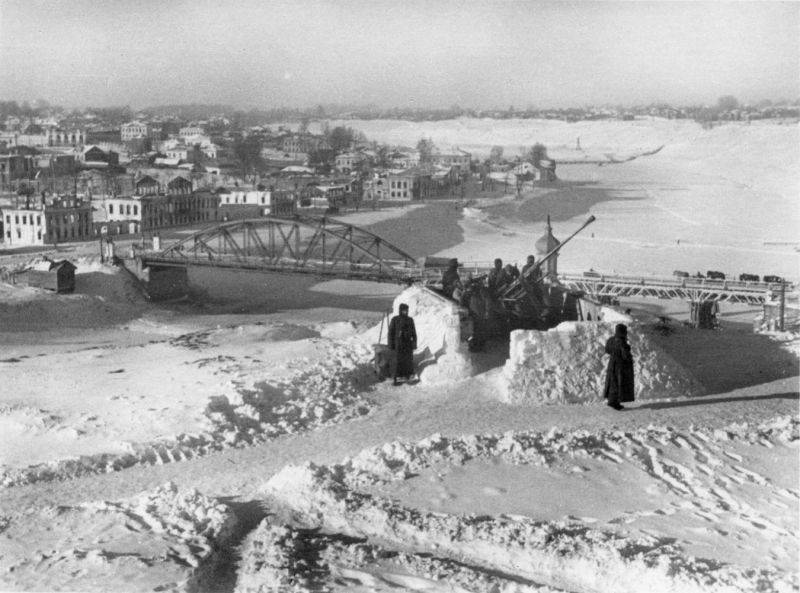
German anti-aircraft gunners at the bridge across the Volga in the occupied Rzhev. Winter 1942. In the center is a German 37 mm FlaK 37 anti-aircraft gun.
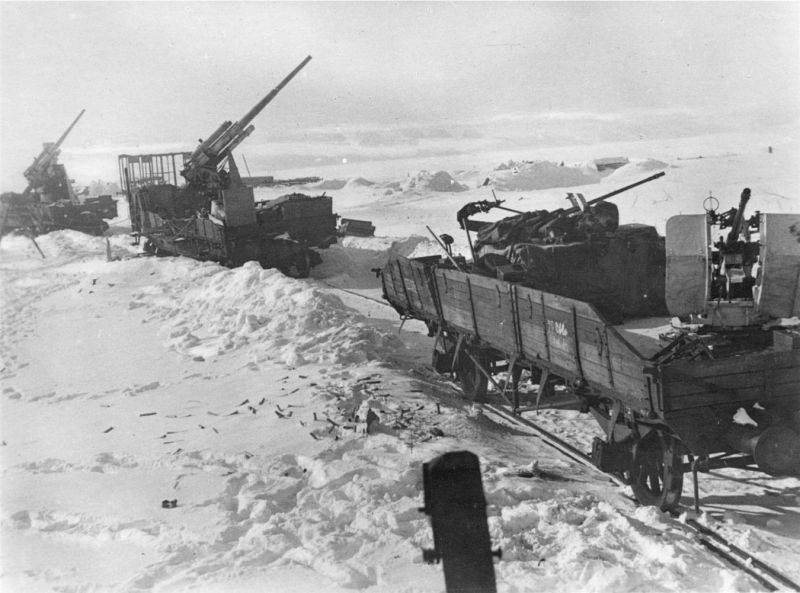
German anti-aircraft battery on railway platforms in occupied Rzhev. 88-mm guns (8,8 cm FlaK 18/36) are installed on the distant platforms, a pair of 37-mm anti-aircraft guns (3,7 cm FlaK 37) are mounted on the right side of the platform
Plans of the Soviet Headquarters
The Soviet Headquarters in the winter of 1943 planned to conduct a series of successive operations in the western (central) direction in order to defeat the German armies and finally push them back from Moscow. First, with concentric strikes by the troops of the Bryansk and the left wing of the Western Fronts, defeat the 2nd German Panzer Army, liberate Oryol and Bryansk. Then develop the offensive on Smolensk, go to the rear of the Rzhev-Vyazma grouping, and with the armies of 4 fronts encircle and destroy the main forces of Field Marshal von Kluge's Army Group Center (2nd and 3rd tank, 4th and 9th field armies ). In the group "Center" there were 77 divisions and one brigade, more than a third of the forces were on the Rzhev bridgehead.
The commander of the Western Front (ZF), Konev, in cooperation with the right wing of the Bryansk Front (BF), was supposed to strike with the forces of the 16th Army, reinforced by the 9th Tank Corps, in the general direction through Zhizdra to Bryansk. Then the 50th and 10th armies were to advance in the general direction to Roslavl, part of the forces - to Yelnya. The commander of the BF, General Reuter, was given the task of defeating the enemy's Oryol-Bryansk grouping. The 48th Army advanced on Orel, covering it from the southwest, the 3rd Army attacked from the east, and the 61st Army attacked from the north, through the Volkhov. This led to the encirclement and defeat of the main forces of the German 2nd Panzer Army. The 13th Army, in cooperation with the 16th Army of the Polar Front, was supposed to liberate Bryansk.
A special role was assigned to the troops of the Central Front (CF) under the command of Rokossovsky. The front was created on February 15, 1943 on the basis of the disbanded Don Front. The new front was deployed north of Kursk between the Bryansk and Voronezh fronts. The front was to include the 21st, 65th, 70th combined arms, 2nd tank, 16th air armies, a number of formations from the Stavka reserve. Rokossovsky's armies were to reach the Dnieper in the region of Gomel and Orsha, making a deep envelopment of the right wing of Army Group Center in order to defeat the main enemy forces in a huge cauldron in the Smolensk region, together with the troops of the Kalinin and Bryansk fronts.
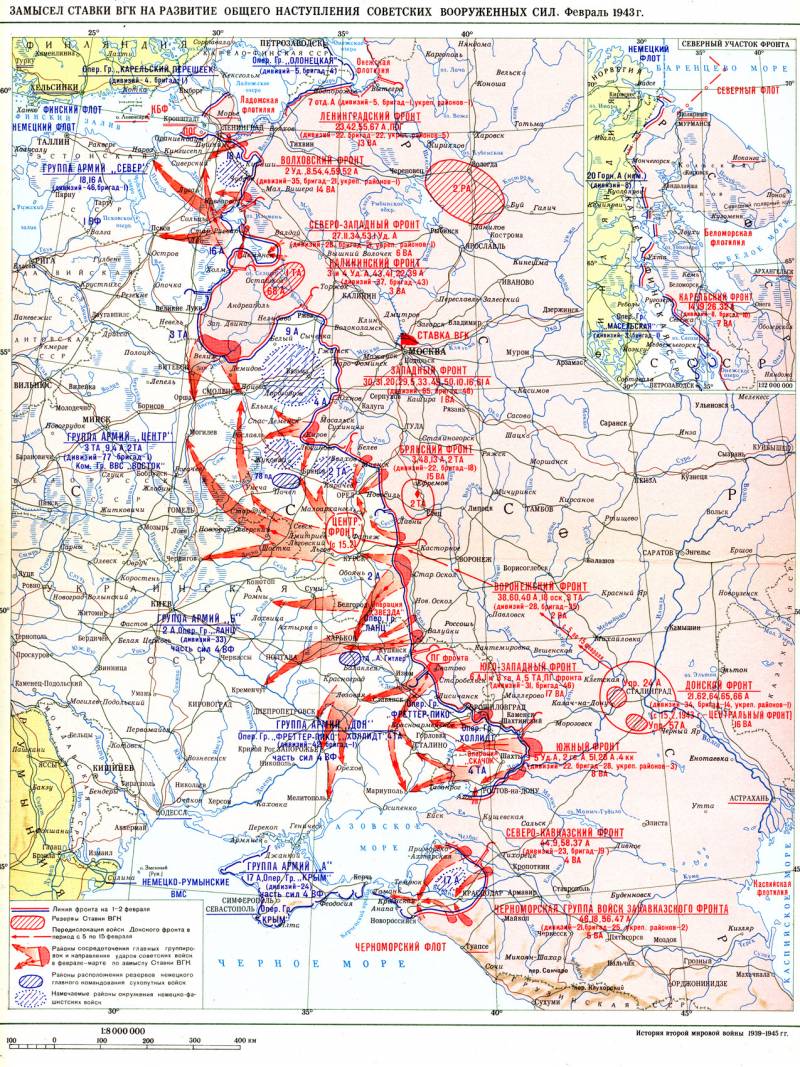
Maloarkhangelsk operation
The fronts of the central direction went over to the offensive at different times, as soon as they were ready. The BF troops went on the offensive first. From the beginning of February 1943, they continuously attacked enemy positions. On February 12, Pukhov's 13th Army and Romanenko's 48th Army, trying to bypass Oryol from the southeast and south, resumed their offensive against the right wing of the German 2nd Panzer Army. Due to the lack of serious mobile formations, the offensive of the two armies was reduced to frontal attacks on enemy positions. The interaction of the Soviet armies was weak. The German command had already withdrawn part of the troops from the Rzhev-Vyazemsky bridgehead, several divisions were transferred to the Oryol direction, strengthening its defense.
The Oryol (Maloarkhangelsk) operation did not lead to success. For a month of stubborn fighting, our troops penetrated the enemy's defenses by 10–30 km. The troops were forced to stop the offensive at the Novosil, Maloarkhangelsk, Rozhdestvenskoye line. The front line remained there until the end of the summer of 1943. The losses were large (over 50 thousand people). March 12, the Bryansk Front was abolished, Reiter headed the Reserve Front.
Other participants in the large-scale plan conceived by the Headquarters to defeat Army Group Center did not have time to prepare for the operation. So, the task of preparing the operation to liberate Bryansk, the commander of the 16th army, General Bagramyan, received on February 9. The army was seriously reinforced with infantry, tanks and artillery. But the main part of the reserves arrived already in the course of the operation, with a great delay, and they were not introduced into the battle at the best moment. Bagramyan simply could not gather all the divisions at the starting line in a few days, organize interaction and supplies, and establish reliable communications.
The troops of the former Don Front, the new Central Fleet, simply did not have time to move from the Stalingrad region to a new location. The only restored single-track railway could not cope with the transfer of several armies.
Mixed formations began to arrive in the area of concentration. The material part of the artillery was unloaded for its intended purpose, and the horses and vehicles were still in place.
There were also cases when equipment was unloaded at one station, and troops at another. Echelons were stuck at stations and sidings for several days.
As a result, many units and rear institutions remained near Stalingrad. The area of concentration, just liberated from the enemy, was not prepared to receive such a large mass of troops and equipment. Off-road exacerbated the situation.
Therefore, it was not possible to form the Central Front by February 15, 1943 and at the same time launch an offensive. Thus, the administration of the 65th Army arrived in Yelets only on February 18, and the main forces of the army - a week later. The 21st Army completed the transfer only by the beginning of March. Tarasov's 70th Army, recruited from the personnel of the border and internal troops of the NKVD, the newly formed 2nd Rodin Tank Army and Kryukov's 2nd Guards Cavalry Corps were transferred from the Stavka reserve to the Central Fleet. But they didn't succeed either. Of the more than 400 tanks of the tank army, after a 270-kilometer march to the starting line in the Fatezh area, only a little more than 100 vehicles reached the appointed time, without artillery, rear units, almost without fuel and provisions. The cavalry corps arrived without guns, convoys, ammunition and fodder. Tarasov's army had to make the hardest winter march, breaking through snowdrifts and snowstorms, dragging guns and materiel on itself.
As a result, the start of the operation was postponed three times, and all the same, the armies of the Central Fleet launched an offensive in parts. The 65th and 2nd tank armies launched the offensive first, the rest of the troops were brought into battle upon arrival. The result was obvious. The rush didn't do any good. It is obvious that the Soviet command was sure that the enemy was broken, it was only necessary to finish him off. Hence the overestimation of one's own forces and the underestimation of the enemy.
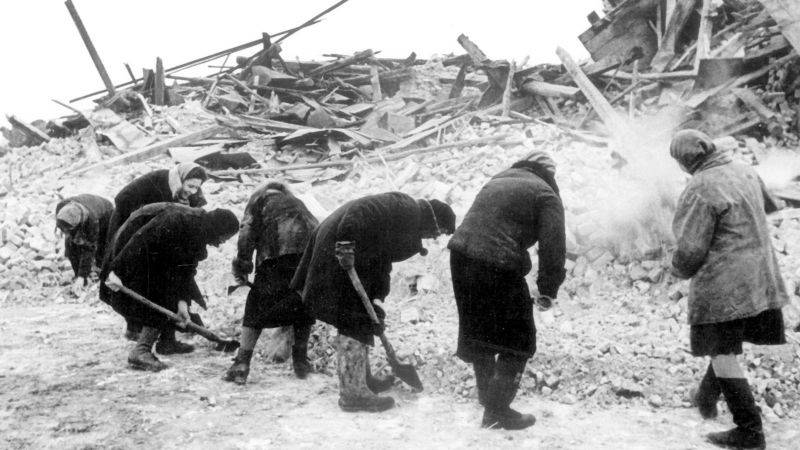
Women clear rubble on the street of the liberated Maloarkhangelsk.
Zhizdra operation
On February 22, 1943, the 16th army of Baghramyan ZF went on the offensive. A strike group of 6 rifle divisions and 4 tank brigades attacked in a 16 km zone and was supposed to capture Zhizdra and Lyudinovo by the end of the first day. From this line, a mobile group consisting of the 9th Panzer Corps, a rifle division and a ski regiment entered the battle, which received the task of liberating Bryansk with a quick throw.
However, our troops were unable to break through the enemy's strong defenses (two German infantry divisions) on the move. Our reconnaissance did not open the enemy’s defenses, artillery hit the squares, aviation acted unsatisfactorily. In addition, German intelligence revealed the preparation of the Russians for the offensive. The German command sent reinforcements to a dangerous place in time. The German Air Force was active. The Germans counterattacked.
The command of the ZF threw in the battle suitable units of fresh divisions. The Germans also transferred new reinforcements, divisions that were released after the withdrawal of troops from the Rzhev bridgehead. The battle turned into a "meat grinder", both sides suffered heavy losses.
By the beginning of March, Baghramyan's army had advanced 10–13 km and had exhausted its offensive potential. The 16th Army halted the advance to put the troops in order and await the arrival of reinforcements. On February 27, Konev was removed from the post of commander of the Western Front with the wording "as he had not coped with the tasks of leading the front" and recalled to Moscow. Sokolovsky was appointed commander of the ZF.
On March 7 and 19, the 16th Army again tried to break through the enemy defenses, achieving local successes. But she was deprived of the 9th Panzer Corps, which was transferred to another sector of the front, and Baghramyan's army could not develop success. The Germans pulled up three more divisions and recaptured a number of positions. ZF finally went on the defensive.
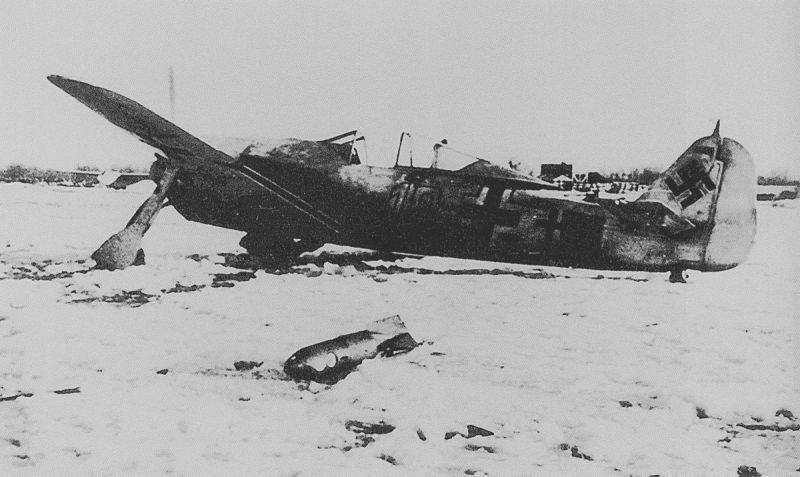
Destroyed German Focke-Wulf Fw.190A fighter at the airfield in Bryansk. March 1943
Sevskaya operation
Rokossovsky's troops were able to go on the offensive on February 25, 1943. The Dmitriev-Sevskaya offensive operation, also known as the Sevsko-Oryol offensive operation and the Sevskaya operation, began.
The main blow from the Kursk-Fatezh line in the general direction to Sevsk with the task of intercepting the Bryansk-Gomel railway was delivered by the 65th Army of Batov (7 rifle divisions and one brigade, an artillery division and 5 separate tank regiments) and the 2nd Tank Army Rodin ( 11th and 16th tank corps, guards tank brigade and regiment, 2 rifle divisions and one rifle brigade, anti-aircraft artillery division). On the right wing, Tarasov's 70th army (6 rifle divisions) was advancing, aimed at Dmitrovsk-Orlovsky. On the left wing there was a cavalry rifle group (3rd and 4th Guards Cavalry Divisions, 3 ski brigades and 2 separate tank regiments), which was advancing on Novgorod-Seversky. The front included over 250 thousand people (excluding the 21st Army) and about 600 tanks.
The operation looked smooth only on paper. Already at the stage of formation of the Central Front, big problems began, they pursued the front further. Most of the tanks and artillery of the tank army were still on the march by the beginning of the operation due to lack of fuel and bad roads. By the beginning of the operation, out of 408 tanks, only 182 tanks were able to go into battle. The main forces of Batov's 65th army made a 60-kilometer march from the place of unloading to the starting line and immediately went into battle. The 70th Army also made a heavy march. The 21st Army has just begun unloading in the Yelets area. In the cavalry rifle group, only the 2nd Guards Cavalry Corps arrived on time. The skiers were on the march, the tanks were waiting for fuel in Livny. Of the 20 artillery and mortar regiments of the Reserve of the Supreme High Command assigned to the front, not one arrived.
Rokossovsky noted that due to the haste of the transfer of armies to a new area, the troops were not familiar with the area, did not conduct reconnaissance, the formations were without transport and communications, supplies. The offensive had to be launched on the move, without reconnaissance, study of the terrain, without rear lines, means of reinforcement, on limited supplies of fuel and ammunition.
However, the start of the operation was quite successful. The 11th tank corps of General Lazarev was the first to go on the offensive. On the evening of February 24, 1943, the forward detachments of the corps launched an offensive. Then the 16th Panzer Corps struck. Fearing the "bag", the Germans left Dmitriev-Lgovsky. To the south, Kryukov's cavalry corps successfully launched an offensive. But the 65th army of Batov immediately ran into a strong enemy defense, every height and village had to be taken with heavy fighting. On the day the army slowly pressed the enemy for 2–4 km.
On March 2, our tankers liberated Sevsk. A day later, without encountering strong resistance and advancing 30 km, Soviet tanks were at the Suzemka station, on March 3 - at the Seredina-Buda station. Army Motherland intercepted the iron line Bryansk - Konotop. On March 7, Soviet tanks reached the left bank of the Usozha River. Kryukov's cavalrymen, without encountering difficulties, traveled 120 km and reached the Desna near Novgorod-Seversky. At the same time, the flanks of the corps were open.
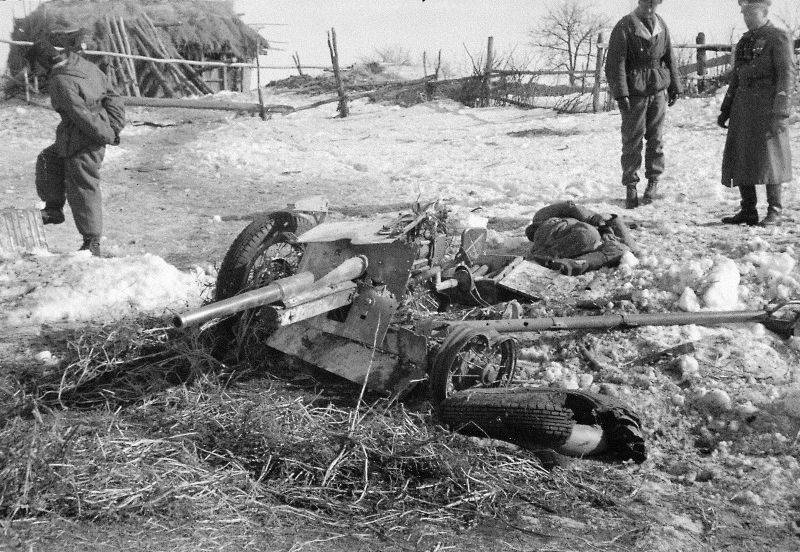
Soldiers of the 35th tank regiment of the Wehrmacht at the broken Soviet 45-mm gun 53-K in the occupied village of Seredina-Buda. Kursk region. March 1943
To be continued ...
Information